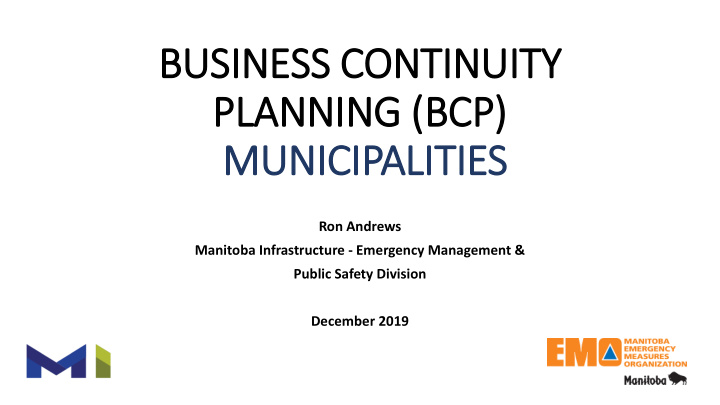



BUSINESS C SS CONTI TINUITY Y PLANN NNING NG ( (BCP) MUNIC ICIP IPALIT ITIE IES Ron Andrews Manitoba Infrastructure - Emergency Management & Public Safety Division December 2019
WHAT IS BUSINESS CONTINUITY ? Business Continuity • All-hazards Incident Management discipline that ensures the availability of critical operations and services when faced with a significant business disruption • Uses the principles & practices of both Enterprise Risk & Emergency Management Business Continuity Planning (BCP) • The cyclical and team-based processes undertaken to ensure continuity Business Continuity Management (BCM) • Holistic governance framework, supported by executive staff and senior management, through which BCP occurs
WHY BUSINESS CONTINUITY ? • All organizations experience disruptions • BCP concentrates on the “people, processes and things” required to keep critical functions operational • When activated, continuity plans ensure a pre-determined and acceptable level of service for stakeholders • BCP builds organizational resilience by protecting critical assets, brand value and key stakeholder interests • A requirement in The Emergency Measures Act – Local Authorities Emergency Planning and Preparedness Regulation (2018-01-16)
WHERE APPLIED ? • BCP applies to all critical* functions within the organization • Non-critical functions may be, but are not normally, addressed • Special planning attention is given to • Internal Dependencies • Shared Inter-dependencies • Critical Service Providers • Supply Chain Considerations • Single Points of Failure *Defined through impact and time-sensitivity
WHO AND WHEN? • Municipality Leadership and those directly responsible for the operation of critical functions and services undertake continuity planning • Stakeholders, critical suppliers, other municipalities may be involved in your planning efforts • Planning is always cyclical – GOM currently uses a 24 month BCP Cycle, in which continuity planning elements and timelines are determined • Leadership reviews and approves the work produced from each cycle element • BCP is never a one-time project – it is a renewable program
BCP CYCLE ELEMENTS
HOW - RISK ASSESSMENT • Conduct team-based discussions on organizations risks, hazards, and vulnerabilities – especially those that may affect critical functions and services • Discuss all potential risks, but focus on high probability/ high impact ones • Document discussions on usable and shareable formats (Spreadsheets, Infographs, Heat Maps, Charts, etc.) • Pursue obvious and available risk mitigation and risk management strategies, options and actions
HOW - BUSINESS IMPACT ANALYSIS • Distinguish critical from non-critical functions and services within your organization • Determine impacts of the non-availability of critical function(s) • Determine the Recovery Time Objective (RTO) for each critical function in hours/ days/ weeks • Determine – and document – required resources to maintain a minimally- acceptable level of service for your critical function(s) • Document any special requirements, dependencies and supply chain resources that are required to maintain your critical function(s)
HOW - STRATEGIES & CONTINUITY PLAN Strategies • Identify viable continuity & recovery strategies for your critical function(s) • Consolidate these strategies to reduce costs and/ or complexity Plan • Clearly outline the “people, processes, and things” required to keep critical function(s) operational – make this a user-friendly document • Include helpful flowcharts/ visuals and appendices, if required • Clearly document Incident Response (BCP) Team roles & responsibilities • Produce in multiple formats and copy to EMO and stakeholders
HOW - PLAN EXERCISES • Determine your exercise, audit and maintenance requirements and align them with your BCP Cycle • Benchmark your exercise requirements against an industry or professional standard, or regulation • Determine the type(s) of exercises suitable (Plan Review, Functional Table- Top or Scenario-Based Exercise) • Incorporate exercise findings (gaps, vulnerabilities) into your revised BCP • Communicate your findings, where appropriate • Renew the BCP Cycle
CRITICAL ELEMENTS FOR SUCCESS • Executive direction, resourcing and continual support for cyclical BCP • Organizational cultural awareness and effect on risk appetite • Continuity planning groups & defined roles for all critical functional areas • Clear and sustainable program and improvement outcomes • Be strategic in orientation and tactical in intended outcomes • Be pragmatic – determine your cost/ benefit(s) and value-added • Ongoing training & staff development • Maintain and exercise your BCP to meet emerging risks and hazards • Define a maturation path that builds organizational resilience
NEXT STEPS & RESOURCES • Review your existing Emergency Plan and examine where you might incorporate BCP elements • Develop a new BCP to protect your critical functions and services • Access available Continuity Planning resources • Self-initiated learning • EMO – planned online resources • Your regional Emergency Management Advisor • Certification (DRI Canada, Business Continuity Institute, etc.) • MI – EMPS Senior BCP Manager • Subject Matter Experts and Contractors
THANK YOU! Ron Andrews Senior Business Continuity Manager Manitoba Infrastructure Emergency Management & Public Safety Division 1525-405 Broadway Avenue Winnipeg, Manitoba R3C 3L6 (204) 232 – 8629 ron.andrews@gov.mb.ca
Recommend
More recommend